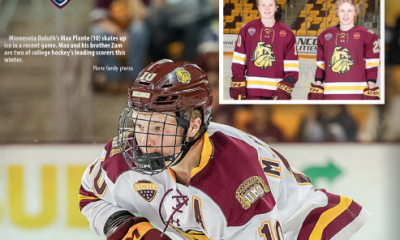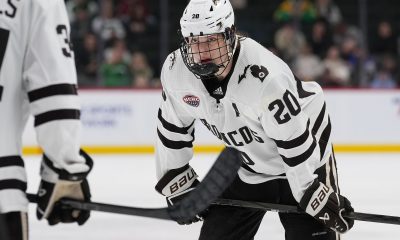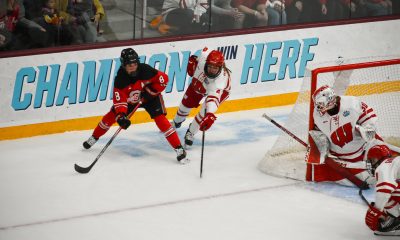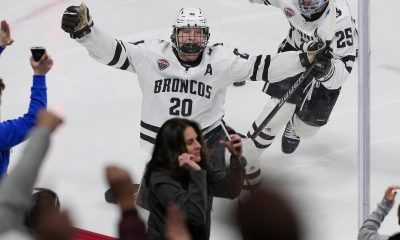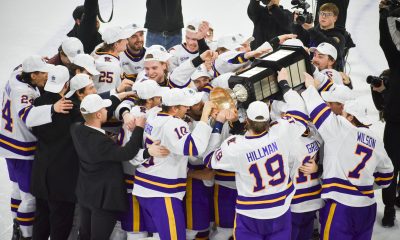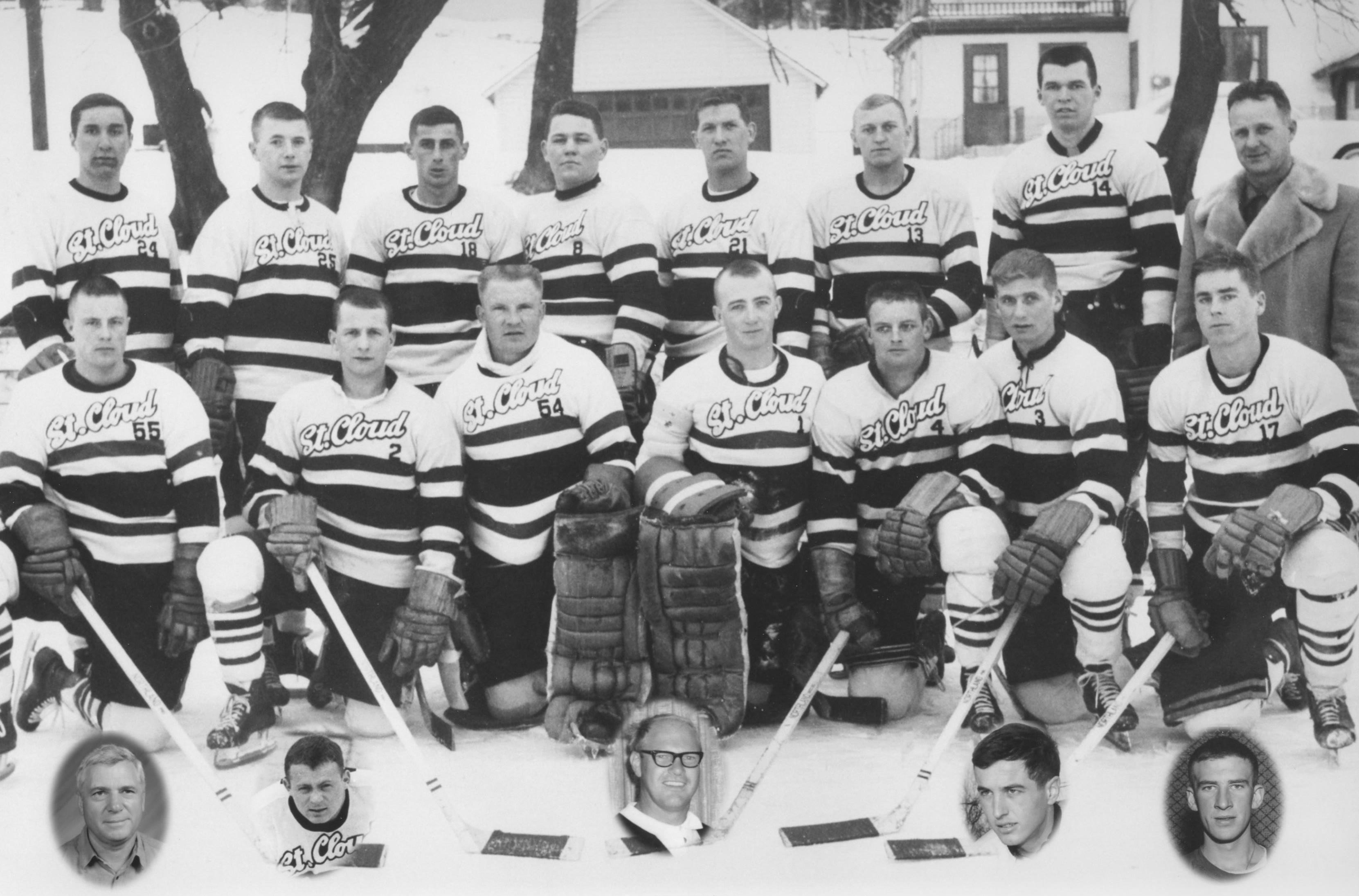
Only 17 indoor ice rinks existed in Minnesota, and none of them were in St. Cloud, making every Huskies game a Winter Classic of sorts during the 1960s. Few were bigger than a Saturday afternoon showdown against Bemidji State on Jan. 27, 1962, the centerpiece sporting event during St. Cloud State College Sno Days.
One year earlier, the Beavers dealt St. Cloud what was to be its only defeat of the season, a 4-1 setback in the second game of a Saturday doubleheader in Bemidji, and now the Huskies hoped to serve revenge cold, on their home ice, amidst the snow sculptures and pageantry of their annual winter carnival.
Bemidji came to the Granite City with eight Canadians on its roster including Paul Lafond, a senior center from Rainy River, Ontario, who paced the team in scoring for three straight seasons. St. Cloud countered with a Minnesota-made roster. Ed Noble, a senior wing from Minneapolis, and Henry “Skeeter” Hawkinson, a sophomore center from Wayzata, were the headliners, along with goaltender Rod Pickett, a junior from Baudette.
Now on opposite sides of the Bemidji-St. Cloud rivalry, only the Rainy River separated Lafond and Pickett during their schoolboy days. In fact, they played high school hockey together, in Baudette, due to Lafond moving in with his aunt and uncle south of the border. Then they went west together, enrolling at the University of North Dakota and skating with the Fighting Sioux freshmen. The prairie proved an ill fit for both, with Lafond packing for Bemidji and Pickett thinking about the Army after a single year in Grand Forks. Pickett’s sister, who lived just outside the St. Cloud city limits, suggested a less drastic alternative.
“She talked me into coming (to St. Cloud State),” said Pickett. “Her and Bill Fritsinger.”
A former high school teammate from Baudette, Fritsinger was already skating with the Huskies when the long-distance call came from North Dakota. He told Pickett to pack his pads and enroll. Changing schools, and hockey programs, was less bureaucratic in the early 1960s. Three days later, Pickett was starting in goal for the Huskies.
He soon discovered that many of his teammates were also refugees of a sort. Pickett became the fifth of St. Cloud’s front-line standouts to transfer in after a year of freshman hockey at the University of Minnesota or North Dakota. Others had served Army stints. Almost all of them were in their early 20s and most of them were looking for a fresh start.
“There was a group of us who realized, ‘geez, we need to get serious and graduate at some point,’” recalled Nobel, who would serve as the Huskies captain. “The University of Minnesota was big – there were so many students – so it was impossible to get the classes you needed. It wasn’t conducive to graduating. St. Cloud State was a smaller school, it was affordable, we could get our degrees and we could play hockey. That made it attractive for us.”
Phil Gens, another Minneapolis product, joined Nobel in St. Cloud. He remembered paying something like $50 for a quarter’s worth of credits and having enough gas money left over to play weeknight senior hockey games back in the Twin Cities. For him – and for so many of the Huskies – it was a perfect fit at the perfect time.
Sno Days Showdown
Temperatures hovered near zero, which made the still-falling snow crunch stiffly under the boots of St. Cloud students who lined the wooden boards. Among them was King Bruce Bauer and Queen Alma Shay, the newly minted Sno Days royalty, who joined the frozen festivities. The Sno Ball was still to come – maybe a cold beer and a warm slow dance too – but it would all be sweeter with an afternoon triumph over Bemidji.
St. Cloud entered the game undefeated in five contests, having bested Hamline University, Carleton College (twice), Northland College and the University of St. Thomas. Bemidji was 4-1, with its only loss coming at St. Thomas. The Huskies and Beavers were not only combatants for statewide small-school superiority, but on a more personal level as well.
St. Cloud’s Baudette trio – Pickett, Fritsinger and Jim Humeniuk, a defenseman – was raised 100 miles north of Bemidji and just across the border from some of the Beavers’ Canadian imports, stoking back-home rivalries that were friendly, but much more pleasant for the winning side.
“We had to beat Bemidji during the winter because we had to live with them during the summer,” said Pickett. “Any time we beat Bemidji, it was special for the three of us from Baudette because we could pour it on those guys all summer long.”
But before they could battle for bragging rights, the St. Cloud contingent had to clean the ice. There was no Zamboni and no arena crew to help. If the Huskies wanted to skate, they had to flood and scrape themselves – before, after and during the games.
“Our season didn’t start until winter quarter and that was always somewhere around the first week in January,” recalled Pickett. “Many of us would come back early from Christmas break to help build the ice. The maintenance crew would put up the boards and the rest was left up to us. On game days, we flooded and prepared the ice before the game and we scraped the ice between periods while our opponents rested. If it happened to be snowing that day, the official would stop play during the period and we would be responsible to remove the snow.”
Most of St. Cloud’s players came from the Twin Cities, where even the high school games were played inside, so the transition back to the elements was harsh, but not necessarily unpleasant.
“There was definitely some culture shock going from playing at the Minneapolis Arena, the St. Paul Auditorium or Williams Arena to playing outside, but that kind of added to the whole program at St. Cloud,” said Harry Stanius, a sophomore defenseman on the 1961-62 squad.
It was common to find a handful of Huskies, dimly lit by a frigid mid-winter moon, dousing the ice at midnight. On those late nights, covered in wool, leather and frozen slush, the St. Cloud boys forged a sturdy bond.
“We’d go to class, go to practice, go home to get something to eat, then come back to the rink to shovel and flood,” recalled Pickett. “It was a helluva effort, but we did it because we wanted to play. That was part of the reason our team had such great camaraderie – all that extra work we did together to take care of the rink.”
The Sno Days showdown against Bemidji was aptly named, with a steady snow falling throughout. That meant St. Cloud would have to beat the Beavers and the elements. With the festive crowd shuffling to stay warm, Gary Thorp, a junior center from Minneapolis, gave them reason to cheer with an early goal for St. Cloud. Bemidji tied it late in the first period, but St. Cloud struck twice in the second period with goals from Denny Songle and Les Etienne. The Beavers closed the margin to 3-2 late in the second, but as he so often did, Hawkinson put the game out of reach with a third-period goal.
A mid-1950s prep standout at Minnetonka High School, Hawkinson paired with Francis Rapley to lead the Skippers to their first taste of major success when, as seniors, they posted a 14-4-1 record in 1956. Both eventually found their way to the college hockey ranks – Hawkinson after an Army stint – becoming the first Minnetonka players to do so. Hawkinson starred in St. Cloud, while Rapley played for the Huskies’ bitter rival to the west, St. John’s University.
“Skeeter was the heart and soul of our team,” said Noble, who skated alongside him and Gens on the Huskies’ top line. “Some athletes are skilled, some have a head for the game and a love for the game, and some are fiercely competitive. Skeeter was all of this, along with having the speed to take the game to its highest level. He was someone special.”
Hawkinson’s goal gave St. Cloud a two-goal margin, which proved to be just enough as the Beavers scored late in the third, but couldn’t produce an equalizer.
Zeroes and Fisticuffs
Three days later, the Huskies embarked on a two-game shutout streak that pushed their record to 8-0. First they beat St. John’s 5-0, with backup goalie Dale Carmichael between the pipes, then Pickett posted a 20-save shutout against MIAC power St. Thomas in a 2-0 triumph. After a dominating 4-1 win at Gustavus, St. Cloud boarded the bus for Collegeville and a final battle with St. John’s on Feb. 8, 1962.
It was always a hotly contested rivalry — and this one set a new standard.
“We were afraid we weren’t going to get out of Collegeville,” recalled Stanius.
As usual, Hawkinson was at the center of it all. Teams did anything they could to slow the diminutive speedster, not excluding the occasional slash, and he took more than his share against St. John’s that day. In the aftermath of an early skirmish, teammates remember Hawkinson telling the Jays, as they were then known, that he’d pound the next guy who slashed him. Sure enough, he kept his promise when the next slash came, fiercely answering with his own lumber. A wild brawl ensued, which took a turn for the worse when St. John’s students started pouring out of a nearby dormitory.
The officials ejected Hawkinson and sent him to the St. Cloud bus, which soon became the target of St. John’s Benedictine-led student population. They tried to board the bus and finish what their hockey team started, but St. Cloud’s bus driver, Beaver, met them at the door with enough discouragement to extinguish the fire. Order was eventually restored and the Huskies skated off intact with a 5-0 shutout victory.
Perfection
Two days later, the Huskies notched an emphatic end to their season by dealing the Beavers a 2-0 defeat in Bemidji. It was St. Cloud’s 11th win, completing the first and only perfect season in school history.
With former opponents like the University of Minnesota Duluth having recently moved up to the big-school University Division ranks, local headlines touted St. Cloud as a premier College Division small-school power.
“St. Cloud State is justifiably taking over the role as the No. 1 college hockey team in the state of Minnesota,” wrote Joe Long of the St. Cloud Times. “The team has lost only three games in three seasons after finishing the current season with a perfect 11-0 record.”
The numbers were, in fact, staggering. Beyond the wins and losses, St. Cloud outscored opponents 64-13 in 1962, with Hawkinson’s 16 goals leading the way.
At one point during the Huskies’ 1962 season, Jack Wink, the St. Cloud football coach who also oversaw the hockey team, told Noble that it was the most fun he ever had as a coach. “He said, ‘you guys shovel and flood your own outdoor rink, you love to work hard during practices that you direct yourselves, and all you do is win. I’ve never coached a team that has such passion for a sport. I love it.’”
The Huskies carried that passion through graduation day and beyond, leaving legacies as teachers, youth hockey coaches and businessmen. They still meet occasionally to reminisce about the old times, catch up on each other’s business deals and enjoy the camaraderie they forged with shovels, hoses and sticks in hand on a frigid outdoor rink in 1962.
Postscript: A Common Goal
Winning was a team effort at St. Cloud State in 1962. Certainly the Huskies had headliners — Hawkinson, Pickett, Noble and Fritsinger posted the eye-popping numbers — but they alone weren’t enough to win. Eighteen men skated in the St. Cloud jersey that magical winter, each making a commitment to each other and to themselves that extended beyond just playing the games.
In addition to Hawkinson, Noble and Fritsinger, the forwards included Minneapolis natives Gens, Thorp, Denny Songle, Rog Googins, Larry Whitleff and Dave Svendsen. They were joined up front by John Duncan, from St. Paul, whose three goals tied for the team lead in goals by a freshman with another St. Paul native, defenseman Al Paulson. Complementing Paulson on the blue line was International Falls native Les Etienne, the Huskies’ top-scoring defenseman, and Jim Humeniuk, who arrived in Central Minnesota from Baudette. The defense corps also included Stanius, Harry Olson and Tim Sherry, all from Minneapolis.
Between the pipes, Pickett was unbeatable – literally. He played two seasons at St. Cloud State without suffering a defeat, inspiring a bold confidence among his teammates. But there were two goaltenders on the roster, and Carmichael turned in his share of highlights as well. One of the sweetest was his 23-save shutout against St. John’s, a victory that pushed St. Cloud’s record to 7-0.
Off the ice, Coach Wink orchestrated the hockey operation, and Ed McGowan, a student assistant coach with an exemplary athletic resume, provided the inspirational speeches.
“He usually told us we should have won bigger,” remembers Noble.
In 1993, McGowan was named to the Minnesota Hockey Coaches Association Hall of Fame. Eleven years later, he was inducted into the Minneapolis Patrick Henry High School Hall of Fame.
—-
A print edition of this story, with premium content including images and game notes, can be ordered by clicking here.
Jayson Hron is the founder, researcher and author of Historically Inclined, a blog which explores and celebrates the way it was, one story at a time. The primary focus is sports history with a sprinkling of outdoor life, architecture, military history and vintage Americana. Occasionally, Historically Inclined may also host an opinion piece or a glimpse into the present, usually within the context of how things used to be better – at least in the world of sports.Hron is also a member of the Society for International Hockey Research, serving currently as editor-in-chief of its annual Research Journal.By day, and often by night as well, he works as USA Hockey's manager of youth hockey communications.





